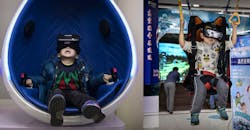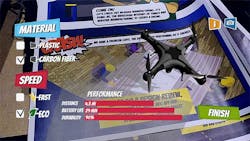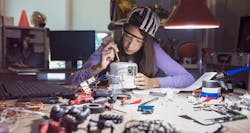If as a kid you read a ton of comic books and watched way too many cartoons like Transformers and X-Men after school, you're darn lucky to be working in manufacturing day. All the futuristic tech used to save—or attempt to conquer—the world are starting to be used as commonplace tools. Robots. Drones. Augmented and Virtual Realities. In the hands of C.O.B.R.A., they could do some real damage G.I. J.O.E. would have to thwart. Why today those are just handy solutions. Robots may weld or fasten, drones can inspect or monitor facilities or infrastructure, and AR and VR stream data to a worker and design new things and places, respectively.
And that's only the beginning. By the time my teenage kids enter the workforce, there will be dozens of new applications integrating all this emerging tech, powered more completely by artificial intelligence and the Industrial Internet of Things, with quantum computers just starting to reach maturity.
I can’t even imagine what the inside of a new factory will look like when my toddlers grow up, but this Manufacturing Day I can show them a glimpse of the future, and potentially lucrative (and fun) careers. PTC, Rockwell Automation and the National Association of Manufacturers teamed up to create the Smart Manufacturing Comic Book, downloadable PDF highlighting how a drone factory will someday look. To get the full experience, print out the nine pages and download the "Smart MFG" app from the Google Play or App Store on a tablet or smartphone. Load it up and point it at the pages.
Through the AR window pane, the robot arms on the production line move and the drones fly off the page. Data from the IIoT provide stats on the manufactured product performs as engineered. It's all to inspire the next generation to take a closer look a career in manufacturing.
We asked Don Busiek, Senior Vice President, Corporate Strategy at PTC, on why they helped put together the comic.
JH: Who is this AR experience for?
DB: The next generation of manufacturers, the students and local community around manufacturing centers in the U.S. This AR experience will inspire young people by demonstrating that manufacturing in a smart connected world is filled with technology, advanced skills, and creativity, which all add up to great opportunity. AR will not only help improve manufacturing productivity, but it will also help drive an increased level of excitement about the manufacturing profession in general.
JH: What do you hope this AR experience does?
DB: Our hope is that the comic book provides an easily accessible path for students to better understand how these emerging technologies in AR, IIoT, and additive manufacturing, etc. are employed in modern manufacturing, as well as highlight different possible career paths that are available.
JH: How did you decide what message to drive home this year?
DB: According to a recent report from Deloitte and the Manufacturing Institute, 80% of manufacturers currently indicate a moderate or serious shortage of qualified applicants. Specifically, they found that over the next decade 3.5 million manufacturing jobs will need to be filled and the skills gap is expected to result in 2 million of those jobs being unfilled. Knowledgeable workers are retiring and we simply do not have the next generation of manufacturing leaders in position to fill their place.
Our message this year is that augmented reality gives you super human powers in manufacturing. We really wanted to demonstrate that manufacturing in a smart connected world is filled with technology, advanced skills, and creativity.
JH: Why is Manufacturing Day so critical for manufacturers?
DB: Manufacturing Day serves as a means of inspiring the next generation to consider careers in manufacturing at a time when it is undergoing a digital transformation. The world of manufacturing is transforming, and technology is driving that process. Many modern manufacturing companies are at the cutting edge of new technologies like the Industrial Internet of Things, additive manufacturing/3D printing, artificial intelligence and analytics, and augmented reality. Manufacturing Day created an opportunity to expose many common misperceptions about manufacturing jobs and hopefully shrink that jobs gap.
JH: It combines so many emerging technologies, many that will be ubiquitous when the tweens who read this join the workforce. How do you think the factory of 2030 will look and what is the risk if we don’t cultivate the talent to operate it?
DB: The factory of 2030 will be dramatically more productive than the factories of today. With AR, IIoT, additive manufacturing, and digital technology platforms, both machines and human labor will be significantly more productive, and innovation will accelerate exponentially at 1/10th of the cost.
For example, unplanned downtime will be at record lows due to IoT enabled predictive maintenance. Factories will be paperless and workers will use AR to increase human productivity. The products produced will be directly aligned with consumers preferences due to IoT enabled integrations with consumer sources such as social media. Supply chains will be lean due to additive manufacturing. Engineers will collaborate on a smaller number of parts that will be printed rather than assembled.
Without the right talent, manufacturers will have difficulty keeping pace with competitors and risk becoming obsolete.
JH: What inspires you about manufacturing?
DB: In a world that is increasingly becoming virtual, we communicate via email or text, we play video games instead of sports, there is really something so gratifying about knowing what you work on helps create the physical products we use in our everyday life. I feel immensely proud when I tell my family that food they are eating, or the car we drive was produced using the industrial technology I work on. Manufacturing is where it is at.
About the Author
John Hitch
Senior Editor
John Hitch writes about the latest manufacturing trends and emerging technologies, including but not limited to: Robotics, the Industrial Internet of Things, 3D Printing, and Artificial Intelligence. He is a veteran of the United States Navy and former magazine freelancer based in Cleveland, Ohio.
Questions or comments may be directed to: [email protected]




